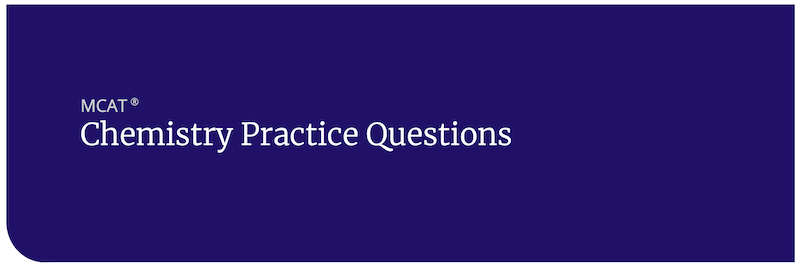MCAT Practice Questions: Chemistry
The MCAT will present you with ten passages based on chemistry and physics subjects, and then present four to seven questions about each passage. The questions will address the four Scientific and Reasoning Skills listed, although different passages will focus on different skills. You will also be asked 15 discrete questions that are completely separate from the ten passages. These discrete questions test both your science knowledge and application of that knowledge based on these four skills, although they tend more toward Skill 1. You can find more details on what you need to know about the overall structure of the MCAT.
The chem/physics section of the MCAT is scored 118-132 on a curved scale, with the median score of all test takers set to be 125. A given scaled score does not correspond to any specific number of right or wrong questions. Instead, each test administration is curved according the performance of the test-takers on that day and the relative level of difficulty of that version of the test. The score for this section of the test is combined with the other three sections to provide your overall score which ranges from 472 to 528.
MCAT Practice Questions: Chemistry
Answer and Explanation
The correct answer is: B
This reaction is a classic example of a neutralization reaction, in which an acid and a base react to form a salt and, usually, water. Although this reaction also fits the criteria for a double- displacement reaction, choice (C), in which two molecules essentially exchange ions with each other, neutralization is a more specific description of the process.
Answer and Explanation
The correct answer is: B
An SN1 reaction is a first-order nucleophilic substitution reaction. It is called first-order because the rate-limiting step involves only one molecule. Choice (A) is true, but does not explain why SN1 reactions have first-order kinetics; the rate- limiting step of an SN2 reaction is also the first (and only) step of that reaction, but SN2 reactions have second-order kinetics, not first-order. Choice (C) is a true statement as well, but again does not explain why the reaction is first- order. Finally, choice (D) is incorrect because it is the rate- limiting step, not the reaction overall, that involves only one molecule.
The AAMC provides specific descriptions of the topics covered within the Chemical and Physical Foundations of Living Systems section of the MCAT. These topics are subdivided into Foundational Concepts 4 and 5, each of which has several sub-categories.
You can also visit the AAMC site to learn more about the MCAT Blueprint.
The Foundational Topics for the Chemical and Physical Foundations of Living Systems are:
4) Physical processes that allow complex organisms to transport materials, sense their environment, process signals, and respond to changes. This is further subdivided into five categories:
4A. Translational motion, forces, work, energy, and equilibrium in living systems
4B. Importance of fluids for the circulation of blood, gas movement, and gas exchange
4C. Electrochemistry and electrical circuits and their elements
4D. How light and sound interact with matter
4E. Atoms, nuclear decay, electronic structure, and atomic chemical behavior
5) Principles that govern chemical interactions and reactions which form the basis for a broader understanding of the molecular dynamics of living systems. This is further subdivided into five categories:
5A. Unique nature of water and its solutions
5B. Nature of molecules and intermolecular interactions
5C. Separation and purification methods
5D. Structure, function, and reactivity of biologically-relevant molecules
5E. Principles of chemical thermodynamics and kinetics
The most important factor you should consider about the chemistry section of the MCAT is how well prepared you are for both the content and the critical reasoning required. To learn more about how to prepare for the test, click here.

